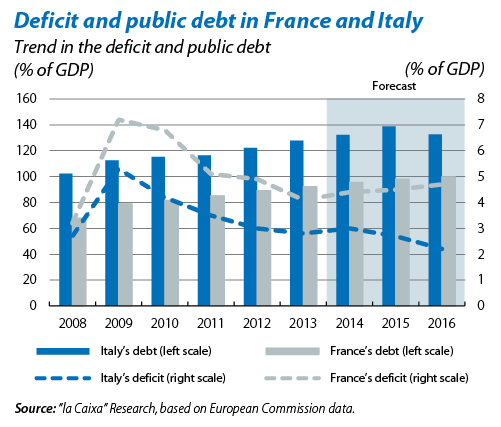
In France, the measures to contain government spending included in its 2015 budget have been estimated at 21 billion euros and this effort is shared by all administrations; central government, local government and Social Security. In spite of these measures, public expenditure is still expected to rise by 0.2% in real terms although we should note that such a low figure is unusual in France: in 2012 the increase was 1.1% and in 2013 it was 1.3%. The government also expects GDP to grow by 1% next year which, should it happen, would help to reduce the share of public expenditure in GDP.
The government spending cuts in Italy's budget total 15 billion euros. The details regarding how the country will achieve such savings, however, have not been as fully specified as the French case, at least at present. More details have been released, however, regarding the considerable reduction planned for the tax burden, which will cost 18 billion euros. The main beneficiaries will be more modest households, which will pay 80 euros less per month in tax.
Consequently, the measures announced to cut government spending are not minor. Nevertheless, it is equally noticeable that, once all these measures are taken into account (including those of tax reductions), the resulting reduction in the deficit is very limited in both cases. The French government forecasts a deficit of 4.3% (4.4% in 2014) when the target initially agreed with Brussels was 3.0% while in Italy the deficit is expected to be 2.6% (3.3% in 2014) compared with a target of 2.2%. Albeit unwillingly, Brussels has accepted these deviations to a certain extent without imposing economic sanctions at present but, in exchange, an agreement has been reached to implement an ambitious agenda of structural reforms. Let us therefore examine this other aspect of the economic situation.
This year France approved its Responsibility and Solidarity Pact which reduces Social Security contributions and corporation tax, on top of the «crédit d'impôt pour la compétitivité et l'emploi» (tax deductions approved in 2013) to make firms more competitive. Moreover, additional measures were announced in October such as a cut in the tax levied on regulated sectors, less bureaucracy for start-ups and a reduction in the number of regions.
For its part Italy plans to simplify its tax system in 2015 (known as the «delega fiscale») as well as carrying out fiscal reforms. Matteo Renzi has also promised to approve the reform of the judicial system, in addition to ambitious labour reforms. The latter have already overcome their first obstacle with the Senate passing the draft bill last October.
The list of reforms seems ambitious in both countries. According to OECD estimates, in France the growth rate could increase by 0.3 pps a year over the next five years should the reforms announced be implemented in their entirety. In the case of Italy, the government estimates that all the reforms presented would increase growth
by 0.1 pps in 2015 and by 0.3 pps in 2016.
In short, it seems as if France and Italy are gradually changing the direction of their economic policy and starting to take measures to boost their economic growth. We should remember, however, that many of the reforms announced have yet to be approved and implemented. Moreover, both countries still have very high levels of debt. They will have to get a move on if they want to stop attracting so much attention.
Recommended Content
Editors’ Picks
EUR/USD clings to daily gains above 1.0650

EUR/USD gained traction and turned positive on the day above 1.0650. The improvement seen in risk mood following the earlier flight to safety weighs on the US Dollar ahead of the weekend and helps the pair push higher.
GBP/USD recovers toward 1.2450 after UK Retail Sales data

GBP/USD reversed its direction and advanced to the 1.2450 area after touching a fresh multi-month low below 1.2400 in the Asian session. The positive shift seen in risk mood on easing fears over a deepening Iran-Israel conflict supports the pair.
Gold holds steady at around $2,380 following earlier spike

Gold stabilized near $2,380 after spiking above $2,400 with the immediate reaction to reports of Israel striking Iran. Meanwhile, the pullback seen in the US Treasury bond yields helps XAU/USD hold its ground.
Bitcoin Weekly Forecast: BTC post-halving rally could be partially priced in Premium

Bitcoin price shows no signs of directional bias while it holds above $60,000. The fourth BTC halving is partially priced in, according to Deutsche Bank’s research.
Week ahead – US GDP and BoJ decision on top of next week’s agenda

US GDP, core PCE and PMIs the next tests for the Dollar. Investors await BoJ for guidance about next rate hike. EU and UK PMIs, as well as Australian CPIs also on tap.